Liposomal Formulation of Botanical Extracts may Enhance Yield Triggering PR Genes and Phenylpropanoid Pathway in Barley (Hordeum vulgare)
Abstract
1. Introduction
2. Results
2.1. Liposome Formation of ELICE16INDURES in the Range of 100–200 nm
2.2. Field Experiments
2.2.1. Increase of Crop Yield in ELICE16INDURES Treated Plots
2.2.2. Higher NDVI in ELICE16INDURES Treated Plots
2.3. RNA-seq Analysis of ELICE16INDURES Treated Plants in Phytotron
2.3.1. De Novo Sequencing and Transcriptome Assembly
2.3.2. Functional Analysis and Classification of Unigenes
2.3.3. Pairwise Differential Expression
2.3.4. Pathway Analysis
3. Discussion
4. Materials and Methods
4.1. Preparation of ELICE16INDURES Plant Conditioner
4.2. Cultivation of Plants and Treatment
4.3. Determination of NDVI by Remote Sensing
4.4. RNA Extraction
4.5. Preparation of RNA-seq Libraries
4.6. Bioinformatics Analysis–Read Processing
4.7. De Novo Assembly of Combined Read Sets
4.8. Functional Annotation
4.9. Gene Level Quantification
4.10. Pairwise Differential Expression Analysis and KEGG Pathway Analysis
4.11. Enrichment Analysis
4.12. Accession Numbers
5. Conclusions
Supplementary Materials
Author Contributions
Funding
Data Availability Statement
Acknowledgments
Conflicts of Interest
References
- Du Jardin, P. Plant biostimulants: Definition, concept, main categories and regulation. Sci. Hortic. 2015, 196, 3–14. [Google Scholar] [CrossRef]
- Calvo, P.; Nelson, L.; Kloepper, J.W. Agricultural uses of plant biostimulants. Plant Soil 2014, 383, 3–41. [Google Scholar] [CrossRef]
- Sharma, H.; Fleming, C.; Selby, C.; Rao, J.; Martin, T. Plant biostimulants: A review on the processing of macroalgae and use of extracts for crop management to reduce abiotic and biotic stresses. J. Appl. Phycol. 2014, 26, 465–490. [Google Scholar] [CrossRef]
- Ugena, L.; Hýlová, A.; Podlešáková, K.; Humplík, J.F.; Doležal, K.; Diego, N.D.; Spíchal, L. Characterization of biostimulant mode of action using novel multi-trait high-throughput screening of Arabidopsis germination and rosette growth. Front. Plant Sci. 2018, 9, 1327. [Google Scholar] [CrossRef] [PubMed]
- Toscano, S.; Romano, D.; Massa, D.; Bulgari, R.; Franzoni, G.; Ferrante, A. Biostimulant applications in low input horticultural cultivation systems= I biostimolanti nei sistemi colturali ortofloricoli a basso impatto ambientale. Italus Hortus 2018. [Google Scholar] [CrossRef]
- Xu, L.; Trinh, H.K.; Geelen, D. Biostimulant mode of action: Impact of PBs on molecular level. Chem. Biol. Plant Biostimulants 2020, 245–259. [Google Scholar] [CrossRef]
- Selivanova, M.V.; Lobankova, O.Y.; Romanenko, E.S.; Esaulko, N.A.; Sosyura, E.A. Effect of growth factors on the metabolism of cucumber crops grown in a greenhouse. Biosci. Biotechnol. Res. Asia 2015, 12, 1397–1404. [Google Scholar] [CrossRef]
- Klokić, I.; Koleška, I.; Hasanagić, D.; Murtić, S.; Bosančić, B.; Todorović, V. Biostimulants’ influence on tomato fruit characteristics at conventional and low-input NPK regime. Acta Agric. Scand. Sect. B Soil Plant Sci. 2020, 70, 233–240. [Google Scholar] [CrossRef]
- Burketova, L.; Trda, L.; Ott, P.G.; Valentova, O. Bio-based resistance inducers for sustainable plant protection against pathogens. Biotechnol. Adv. 2015, 33, 994–1004. [Google Scholar] [CrossRef]
- Vargas-Hernandez, M.; Macias-Bobadilla, I.; Guevara-Gonzalez, R.G.; Romero-Gomez, S.d.J.; Rico-Garcia, E.; Ocampo-Velazquez, R.V.; Alvarez-Arquieta, L.d.L.; Torres-Pacheco, I. Plant hormesis management with biostimulants of biotic origin in agriculture. Front. Plant Sci. 2017, 8, 1762. [Google Scholar] [CrossRef]
- Noutoshi, Y.; Okazaki, M.; Kida, T.; Nishina, Y.; Morishita, Y.; Ogawa, T.; Suzuki, H.; Shibata, D.; Jikumaru, Y.; Hanada, A. Novel plant immune-priming compounds identified via high-throughput chemical screening target salicylic acid glucosyltransferases in Arabidopsis. Plant Cell 2012, 24, 3795–3804. [Google Scholar] [CrossRef] [PubMed]
- Schwessinger, B.; Ronald, P.C. Plant innate immunity: Perception of conserved microbial signatures. Annu. Rev. Plant Biol. 2012, 63, 451–482. [Google Scholar] [CrossRef]
- Latef, A.A.H.A.; Alhmad, M.F.A.; Abdelfattah, K.E. The possible roles of priming with ZnO nanoparticles in mitigation of salinity stress in lupine (Lupinus termis) plants. J. Plant Growth Regul. 2017, 36, 60–70. [Google Scholar] [CrossRef]
- Ye, Y.; Cota-Ruiz, K.; Hernández-Viezcas, J.A.; Valdés, C.; Medina-Velo, I.A.; Turley, R.S.; Peralta-Videa, J.R.; Gardea-Torresdey, J.L. Manganese nanoparticles control salinity-modulated molecular responses in Capsicum annuum L. through priming: A sustainable approach for agriculture. ACS Sustain. Chem. Eng. 2020, 8, 1427–1436. [Google Scholar] [CrossRef]
- Abdel-Aziz, H.; Hasaneen, M.; Omer, A. Impact of engineered nanomaterials either alone or loaded with NPK on growth and productivity of French bean plants: Seed priming vs foliar application. S. Afr. J. Bot. 2019, 125, 102–108. [Google Scholar] [CrossRef]
- Dutta, P. Seed priming: New vistas and contemporary perspectives. In Advances in Seed Priming; Springer: Berlin/Heidelberg, Germany, 2018; pp. 3–22. [Google Scholar]
- Karny, A.; Zinger, A.; Kajal, A.; Shainsky-Roitman, J.; Schroeder, A. Therapeutic nanoparticles penetrate leaves and deliver nutrients to agricultural crops. Sci. Rep. 2018, 8, 7589. [Google Scholar] [CrossRef]
- Conrath, U.; Pieterse, C.M.; Mauch-Mani, B. Priming in plant–pathogen interactions. Trends Plant Sci. 2002, 7, 210–216. [Google Scholar] [CrossRef]
- Choudhary, D.K.; Prakash, A.; Johri, B. Induced systemic resistance (ISR) in plants: Mechanism of action. Indian J. Microbiol. 2007, 47, 289–297. [Google Scholar] [CrossRef]
- Koornneef, A.; Pieterse, C.M. Cross talk in defense signaling. Plant Physiol. 2008, 146, 839–844. [Google Scholar] [CrossRef]
- Doornbos, R.F.; Geraats, B.P.; Kuramae, E.E.; Van Loon, L.; Bakker, P.A. Effects of jasmonic acid, ethylene, and salicylic acid signaling on the rhizosphere bacterial community of Arabidopsis thaliana. Mol. Plant-Microbe Interact. 2011, 24, 395–407. [Google Scholar] [CrossRef]
- Thulke, O.; Conrath, U. Salicylic acid has a dual role in the activation of defence-related genes in parsley. Plant J. 1998, 14, 35–42. [Google Scholar] [CrossRef]
- Shulaev, V.; Cortes, D.; Miller, G.; Mittler, R. Metabolomics for plant stress response. Physiol. Plant. 2008, 132, 199–208. [Google Scholar] [CrossRef] [PubMed]
- Gómez-Ariza, J.; Campo, S.; Rufat, M.; Estopà, M.; Messeguer, J.; Segundo, B.S.; Coca, M. Sucrose-mediated priming of plant defense responses and broad-spectrum disease resistance by overexpression of the maize pathogenesis-related PRms protein in rice plants. Mol. Plant-Microbe Interact. 2007, 20, 832–842. [Google Scholar] [CrossRef] [PubMed]
- Van Loon, L.; Van Kammen, A. Polyacrylamide disc electrophoresis of the soluble leaf proteins from Nicotiana tabacum var “Samsun” and “Samsun NN.” 11. Changes in protein constitution after infection with tobacco mosaic virus. Virology 1970, 40. [Google Scholar] [CrossRef]
- van Loon, L.C.; Rep, M.; Pieterse, C.M. Significance of inducible defense-related proteins in infected plants. Annu. Rev. Phytopathol. 2006, 44, 135–162. [Google Scholar] [CrossRef]
- Van Loon, L.C.; Van Strien, E. The families of pathogenesis-related proteins, their activities, and comparative analysis of PR-1 type proteins. Physiol. Mol. Plant Pathol. 1999, 55, 85–97. [Google Scholar] [CrossRef]
- Akbudak, M.A.; Yildiz, S.; Filiz, E. Pathogenesis related protein-1 (PR-1) genes in tomato (Solanum lycopersicum L.): Bioinformatics analyses and expression profiles in response to drought stress. Genomics 2020, 112, 4089–4099. [Google Scholar] [CrossRef]
- Luo, X.; Tian, T.; Feng, L.; Yang, X.; Li, L.; Tan, X.; Wu, W.; Li, Z.; Treves, H.; Serneels, F. Pathogenesis-related protein 1 suppresses oomycete pathogen by targeting against AMPK kinase complex. J. Adv. Res. 2022. [Google Scholar] [CrossRef]
- Jain, D.; Khurana, J.P. Role of pathogenesis-related (PR) proteins in plant defense mechanism. In Molecular Aspects of Plant-Pathogen Interaction; Springer: Berlin/Heidelberg, Germany, 2018; pp. 265–281. [Google Scholar]
- Shoaib, A.; Al-Shehadah, E.; Jawhar, M.; Arabi, M. Pathogenesis-related genes responses in barley plants challenged with pathogenic fungi with different lifestyles. Cereal Res. Commun. 2020, 48, 341–346. [Google Scholar] [CrossRef]
- Khan, A.; Tabassum, B.; Aaliya, K.; Tariq, M.; Nasir, I.; Hassan, S.; Ismail, T.; Ali, N.; Ponya, Z. The effectiveness of recombinant chitinase obtained from barley (Hordeum vulgare L.) against potato pathogens. Appl. Ecol. Environ. Res 2019, 17, 4147–4157. [Google Scholar] [CrossRef]
- Geddes, J.; Eudes, F.; Laroche, A.; Selinger, L.B. Differential expression of proteins in response to the interaction between the pathogen Fusarium graminearum and its host, Hordeum vulgare. Proteomics 2008, 8, 545–554. [Google Scholar] [CrossRef] [PubMed]
- Rothe, G.M.; Welschbillig, N.; Reiss, E. Molecular size and net charge of pathogenesis-related enzymes from barley (Hordeum vulgare L., v. Karat) infected with Drechslera teres f. teres (Sacch.) Shoem. Electrophoresis 1998, 19, 745–751. [Google Scholar] [CrossRef] [PubMed]
- Kaur, S.; Bhardwaj, R.D.; Kaur, J.; Kaur, S. Induction of defense-related enzymes and pathogenesis-related proteins imparts resistance to barley genotypes against spot blotch disease. J. Plant Growth Regul. 2022, 41, 682–696. [Google Scholar] [CrossRef]
- Pos, V.; Hunyadi-Gulyás, É.; Caiazzo, R.; Jocsak, I.; Medzihradszky, K.; Lukacs, N. Induction of pathogenesis-related proteins in intercellular fluid by cadmium stress in barley (Hordeum vulgare L.)—A proteomic analysis. Acta Aliment. 2011, 40 (Suppl. S1), 164–175. [Google Scholar] [CrossRef]
- Yoshida, K.; Kaothien, P.; Matsui, T.; Kawaoka, A.; Shinmyo, A. Molecular biology and application of plant peroxidase genes. Appl. Microbiol. Biotechnol. 2003, 60, 665–670. [Google Scholar] [CrossRef]
- Caruso, C.; Chilosi, G.; Leonardi, L.; Bertini, L.; Magro, P.; Buonocore, V.; Caporale, C. A basic peroxidase from wheat kernel with antifungal activity. Phytochemistry 2001, 58, 743–750. [Google Scholar] [CrossRef]
- Ji, N.; Wang, J.; Li, Y.; Li, M.; Jin, P.; Zheng, Y. Involvement of PpWRKY70 in the methyl jasmonate primed disease resistance against Rhizopus stolonifer of peaches via activating phenylpropanoid pathway. Postharvest Biol. Technol. 2021, 174, 111466. [Google Scholar] [CrossRef]
- Sharma, A.; Shahzad, B.; Rehman, A.; Bhardwaj, R.; Landi, M.; Zheng, B. Response of phenylpropanoid pathway and the role of polyphenols in plants under abiotic stress. Molecules 2019, 24, 2452. [Google Scholar] [CrossRef]
- Lwalaba, J.L.W.; Zvobgo, G.; Mwamba, T.M.; Louis, L.T.; Fu, L.; Kirika, B.A.; Tshibangu, A.K.; Adil, M.F.; Sehar, S.; Mukobo, R.P. High accumulation of phenolics and amino acids confers tolerance to the combined stress of cobalt and copper in barley (Hordeum vulagare). Plant Physiol. Biochem. 2020, 155, 927–937. [Google Scholar] [CrossRef]
- Chaman, M.E.; Copaja, S.V.; Argandoña, V.H. Relationships between salicylic acid content, phenylalanine ammonia-lyase (PAL) activity, and resistance of barley to aphid infestation. J. Agric. Food Chem. 2003, 51, 2227–2231. [Google Scholar] [CrossRef]
- Kervinen, T.; Peltonen, S.; Teeri, T.H.; Karjalainen, R. Differential expression of phenylalanine ammonia-lyase genes in barley induced by fungal infection or elicitors. New Phytol. 1998, 139, 293–300. [Google Scholar] [CrossRef]
- Quirino, B.F.; Normanly, J.; Amasino, R.M. Diverse range of gene activity during Arabidopsis thaliana leaf senescence includes pathogen-independent induction of defense-related genes. Plant Mol. Biol. 1999, 40, 267–278. [Google Scholar] [CrossRef] [PubMed]
- Ahmed, I.M.; Nadira, U.A.; Bibi, N.; Cao, F.; He, X.; Zhang, G.; Wu, F. Secondary metabolism and antioxidants are involved in the tolerance to drought and salinity, separately and combined, in Tibetan wild barley. Environ. Exp. Bot. 2015, 111, 1–12. [Google Scholar] [CrossRef]
- Bandurska, H.; Pietrowska-Borek, M.; Cieślak, M. Response of barley seedlings to water deficit and enhanced UV-B irradiation acting alone and in combination. Acta Physiol. Plant. 2012, 34, 161–171. [Google Scholar] [CrossRef][Green Version]
- Kalbi, S.; Fallah, A.; Shataee, S. Estimation of forest attributes in the Hyrcanian forests, comparison of advanced space-borne thermal emission and reflection radiometer and satellite poure I’observation de la terre-high resolution grounding data by multiple linear, and classification and regression tree regression models. J. Appl. Remote Sens. 2014, 8, 083632. [Google Scholar] [CrossRef]
- Nagai, S.; Nasahara, K.N.; Muraoka, H.; Akiyama, T.; Tsuchida, S. Field experiments to test the use of the normalized-difference vegetation index for phenology detection. Agric. For. Meteorol. 2010, 150, 152–160. [Google Scholar] [CrossRef]
- Yengoh, G.T.; Dent, D.; Olsson, L.; Tengberg, A.E.; Tucker, C.J., III. Use of the Normalized Difference Vegetation Index (NDVI) to Assess Land Degradation at Multiple Scales: Current Status, Future Trends, and Practical Considerations; Springer: Berlin/Heidelberg, Germany, 2015. [Google Scholar]
- Kefauver, S.C.; Vicente, R.; Vergara-Díaz, O.; Fernandez-Gallego, J.A.; Kerfal, S.; Lopez, A.; Melichar, J.P.; Serret Molins, M.D.; Araus, J.L. Comparative UAV and field phenotyping to assess yield and nitrogen use efficiency in hybrid and conventional barley. Front. Plant Sci. 2017, 8, 1733. [Google Scholar] [CrossRef]
- Peñuelas, J.; Filella, I. Visible and near-infrared reflectance techniques for diagnosing plant physiological status. Trends Plant Sci. 1998, 3, 151–156. [Google Scholar] [CrossRef]
- Rouphael, Y.; Colla, G. Biostimulants in agriculture. Front. Plant Sci. 2020, 11, 40. [Google Scholar] [CrossRef]
- Kutasy, B.; Decsi, K.; Kiniczky, M.; Hegedűs, G.; Virág, E. Time-course gene expression profiling data of Triticum aestivum treated by supercritical CO2 garlic extract encapsulated in nanoscale liposomes. Data Brief 2022, 42, 108287. [Google Scholar] [CrossRef]
- Ali, S.; Ganai, B.A.; Kamili, A.N.; Bhat, A.A.; Mir, Z.A.; Bhat, J.A.; Tyagi, A.; Islam, S.T.; Mushtaq, M.; Yadav, P. Pathogenesis-related proteins and peptides as promising tools for engineering plants with multiple stress tolerance. Microbiol. Res. 2018, 212, 29–37. [Google Scholar] [CrossRef] [PubMed]
- Dörmann, P.; Gopalan, S.; He, S.Y.; Benning, C. A gene family in Arabidopsis thaliana with sequence similarity to NDR1 and HIN1. Plant Physiol. Biochem. 2000, 38, 789–796. [Google Scholar] [CrossRef]
- Yang, F.; Jensen, J.D.; Svensson, B.; Jørgensen, H.J.; Collinge, D.B.; Finnie, C. Analysis of early events in the interaction between Fusarium graminearum and the susceptible barley (Hordeum vulgare) cultivar Scarlett. Proteomics 2010, 10, 3748–3755. [Google Scholar] [CrossRef] [PubMed]
- Singh, P.; Mukhopadhyay, K. Comprehensive molecular dissection of TIFY Transcription factors reveal their dynamic responses to biotic and abiotic stress in wheat (Triticum aestivum L.). Sci. Rep. 2021, 11, 9739. [Google Scholar] [CrossRef]
- Zhang, X.; Ran, W.; Zhang, J.; Ye, M.; Lin, S.; Li, X.; Sultana, R.; Sun, X. Genome-wide identification of the Tify gene family and their expression profiles in response to biotic and abiotic stresses in tea plants (Camellia sinensis). Int. J. Mol. Sci. 2020, 21, 8316. [Google Scholar] [CrossRef]
- Pandey, B.; Grover, A.; Sharma, P. Molecular dynamics simulations revealed structural differences among WRKY domain-DNA interaction in barley (Hordeum vulgare). BMC Genom. 2018, 19, 132. [Google Scholar] [CrossRef]
- Mangelsen, E.; Kilian, J.; Berendzen, K.W.; Kolukisaoglu, Ü.H.; Harter, K.; Jansson, C.; Wanke, D. Phylogenetic and comparative gene expression analysis of barley (Hordeum vulgare) WRKY transcription factor family reveals putatively retained functions between monocots and dicots. BMC Genom. 2008, 9, 194. [Google Scholar] [CrossRef]
- Makki, R.M. Molecular Networking of Regulated Transcription Factors under Salt Stress in Wild Barley (H. spontaneum). Biosci. Biotechnol. Res. Asia 2020, 17, 543–557. [Google Scholar] [CrossRef]
- Santelia, D.; Zeeman, S.C. Progress in Arabidopsis starch research and potential biotechnological applications. Curr. Opin. Biotechnol. 2011, 22, 271–280. [Google Scholar] [CrossRef]
- Kadokawa, J.-i. α-Glucan phosphorylase-catalyzed enzymatic reactions using analog substrates to synthesize non-natural oligo-and polysaccharides. Catalysts 2018, 8, 473. [Google Scholar] [CrossRef]
- Beffa, R.S.; Neuhaus, J.-M.; Meins, F., Jr. Physiological compensation in antisense transformants: Specific induction of an “ersatz” glucan endo-1, 3-beta-glucosidase in plants infected with necrotizing viruses. Proc. Natl. Acad. Sci. USA 1993, 90, 8792–8796. [Google Scholar] [CrossRef] [PubMed]
- Mostek, A.; Börner, A.; Weidner, S. Comparative proteomic analysis of β-aminobutyric acid-mediated alleviation of salt stress in barley. Plant Physiol. Biochem. 2016, 99, 150–161. [Google Scholar] [CrossRef] [PubMed]
- Pogány, M.; Harrach, B.; Bozsó, Z.; Künstler, A.; Janda, T.; von Rad, U.; Vida, G.; Veisz, O. Cold hardening protects cereals from oxidative stress and necrotrophic fungal pathogenesis. Open Life Sci. 2016, 11, 78–85. [Google Scholar] [CrossRef]
- Mauch-Mani, B.; Baccelli, I.; Luna, E.; Flors, V. Defense priming: An adaptive part of induced resistance. Annu. Rev. Plant Biol. 2017, 68, 485–512. [Google Scholar] [CrossRef]
- Katz, V.A.; Thulke, O.U.; Conrath, U. A benzothiadiazole primes parsley cells for augmented elicitation of defense responses. Plant Physiol. 1998, 117, 1333–1339. [Google Scholar] [CrossRef]
- Latunde-Dada, A.O.; Lucas, J.A. The plant defence activator acibenzolar-S-methyl primes cowpea [Vigna unguiculata (L.) Walp.] seedlings for rapid induction of resistance. Physiol. Mol. Plant Pathol. 2001, 58, 199–208. [Google Scholar] [CrossRef]
- Hegedűs, G.; Nagy, Á.; Decsi, K.; Kutasy, B.; Virág, E. Transcriptome datasets of β-Aminobutyric acid (BABA)-primed mono-and dicotyledonous plants, Hordeum vulgare and Arabidopsis thaliana. Data Brief 2022, 41, 107983. [Google Scholar] [CrossRef]
- Mayer, L.D.; Bally, M.B.; Hope, M.J.; Cullis, P.R. Techniques for encapsulating bioactive agents into liposomes. Chem. Phys. Lipids 1986, 40, 333–345. [Google Scholar] [CrossRef]
- Andrews, S. FastQC: A Quality Control Tool for High Throughput Sequence Data. 2010. Available online: http://www.bioinformatics.babraham.ac.uk/projects/fastqc (accessed on 1 October 2022).
- Bolger, A.M.; Lohse, M.; Usadel, B. Trimmomatic: A flexible trimmer for Illumina sequence data. Bioinformatics 2014, 30, 2114–2120. [Google Scholar] [CrossRef]
- Mátyás, K.K.; Hegedűs, G.; Taller, J.; Farkas, E.; Decsi, K.; Kutasy, B.; Kálmán, N.; Nagy, E.; Kolics, B.; Virág, E. Different expression pattern of flowering pathway genes contribute to male or female organ development during floral transition in the monoecious weed Ambrosia artemisiifolia L. (Asteraceae). PeerJ 2019, 7, e7421. [Google Scholar] [CrossRef]
- Grabherr, M.G.; Haas, B.J.; Yassour, M.; Levin, J.Z.; Thompson, D.A.; Amit, I.; Adiconis, X.; Fan, L.; Raychowdhury, R.; Zeng, Q. Trinity: Reconstructing a full-length transcriptome without a genome from RNA-Seq data. Nat. Biotechnol. 2011, 29, 644. [Google Scholar] [CrossRef] [PubMed]
- Langmead, B.; Salzberg, S.L. Fast gapped-read alignment with Bowtie 2. Nat. Methods 2012, 9, 357–359. [Google Scholar] [CrossRef] [PubMed]
- Decsi, K.; Kutasy, B.; Kiniczky, M.; Hegedűs, G.; Virág, E. RNA-seq datasets of field soybean cultures conditioned by Elice16Indures® biostimulator. Data Brief 2022, 42, 108182. [Google Scholar] [CrossRef] [PubMed]
- Anders, S.; Pyl, P.T.; Huber, W. HTSeq—A Python framework to work with high-throughput sequencing data. Bioinformatics 2015, 31, 166–169. [Google Scholar] [CrossRef]
- Robinson, M.D.; McCarthy, D.J.; Smyth, G.K. edgeR: A Bioconductor package for differential expression analysis of digital gene expression data. Bioinformatics 2010, 26, 139–140. [Google Scholar] [CrossRef]
- Virág, E.; Hegedűs, G.; Kutasy, B.; Decsi, K. Transcriptome profiling dataset of different developmental stage flowers of soybean (Glycine max). Data Brief 2022, 43, 108426. [Google Scholar] [CrossRef]
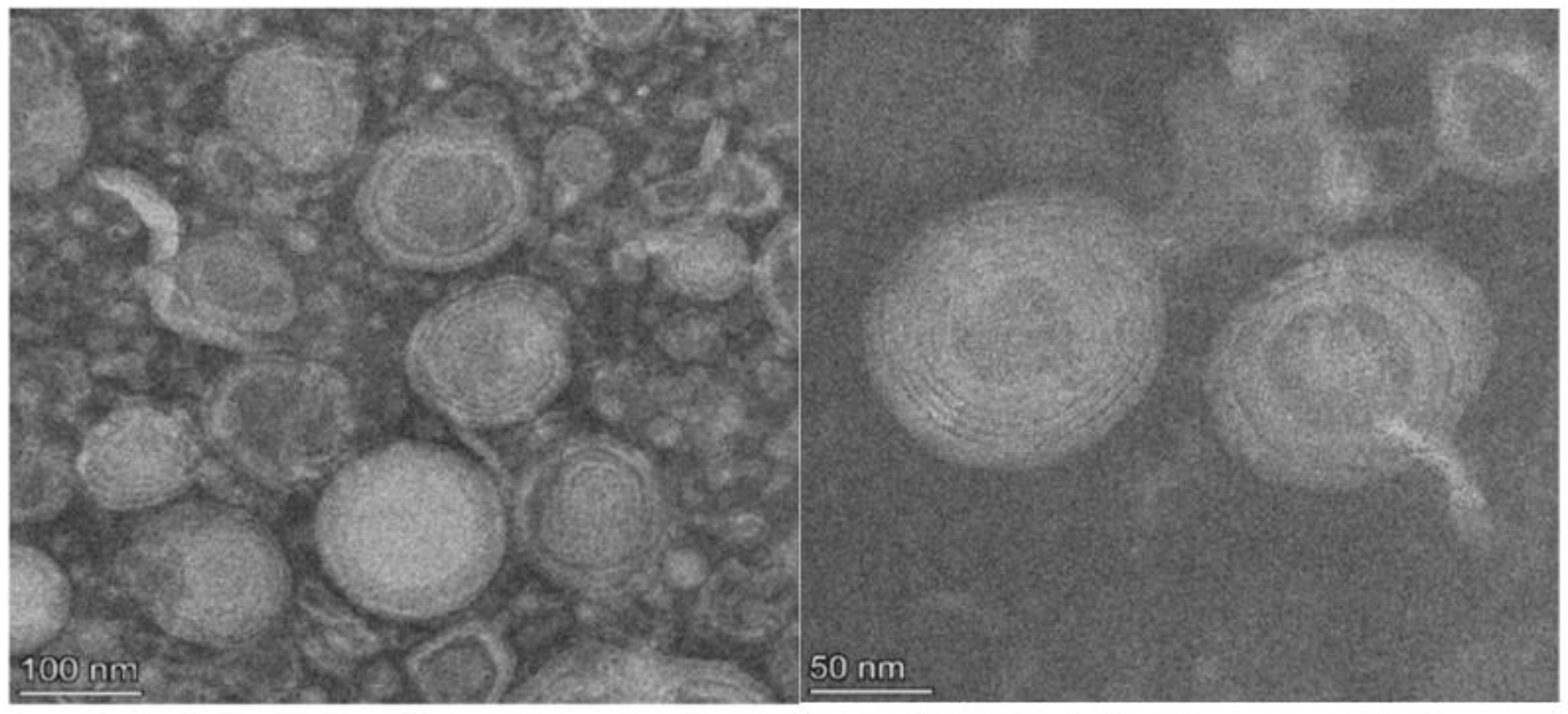
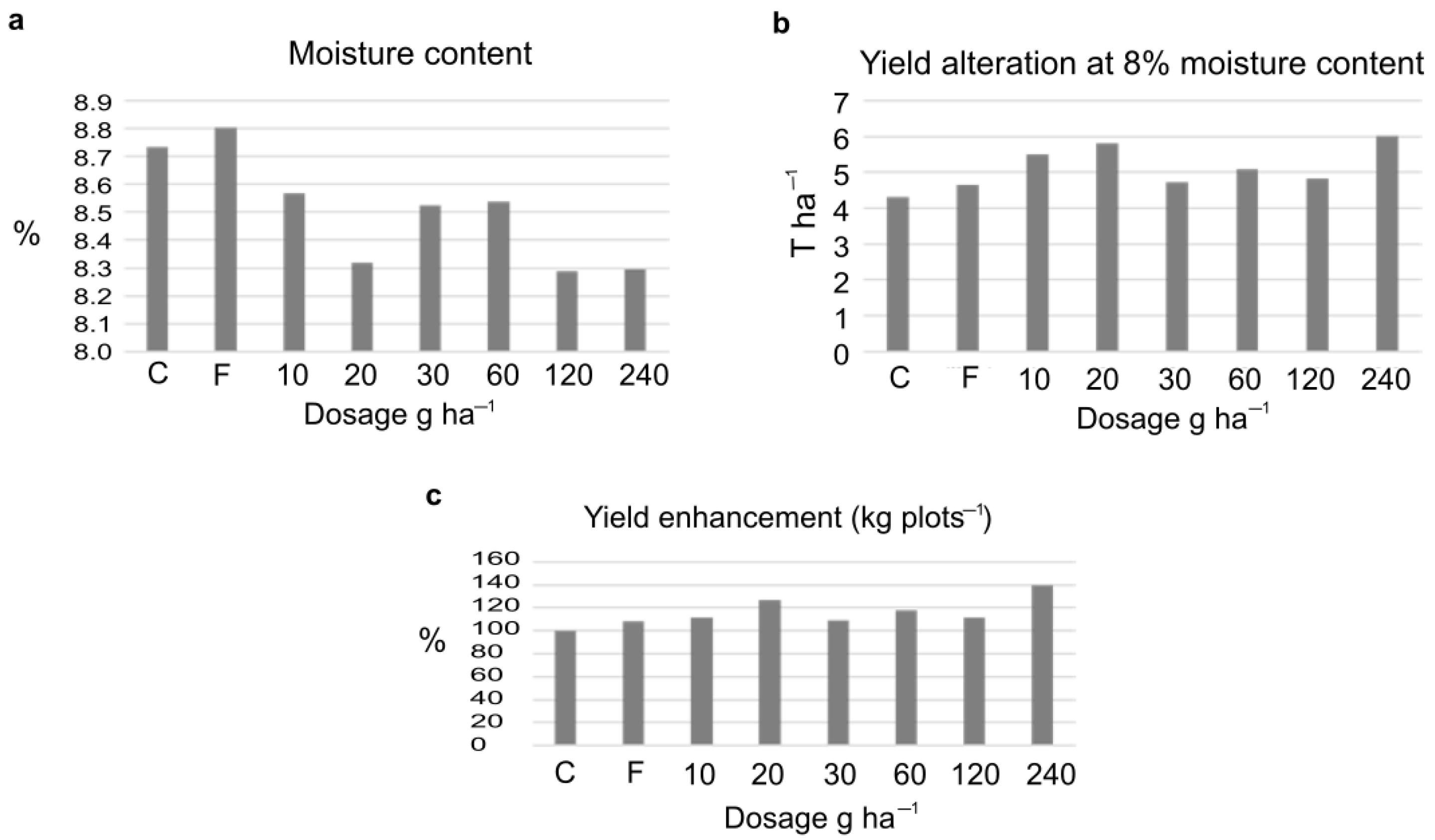
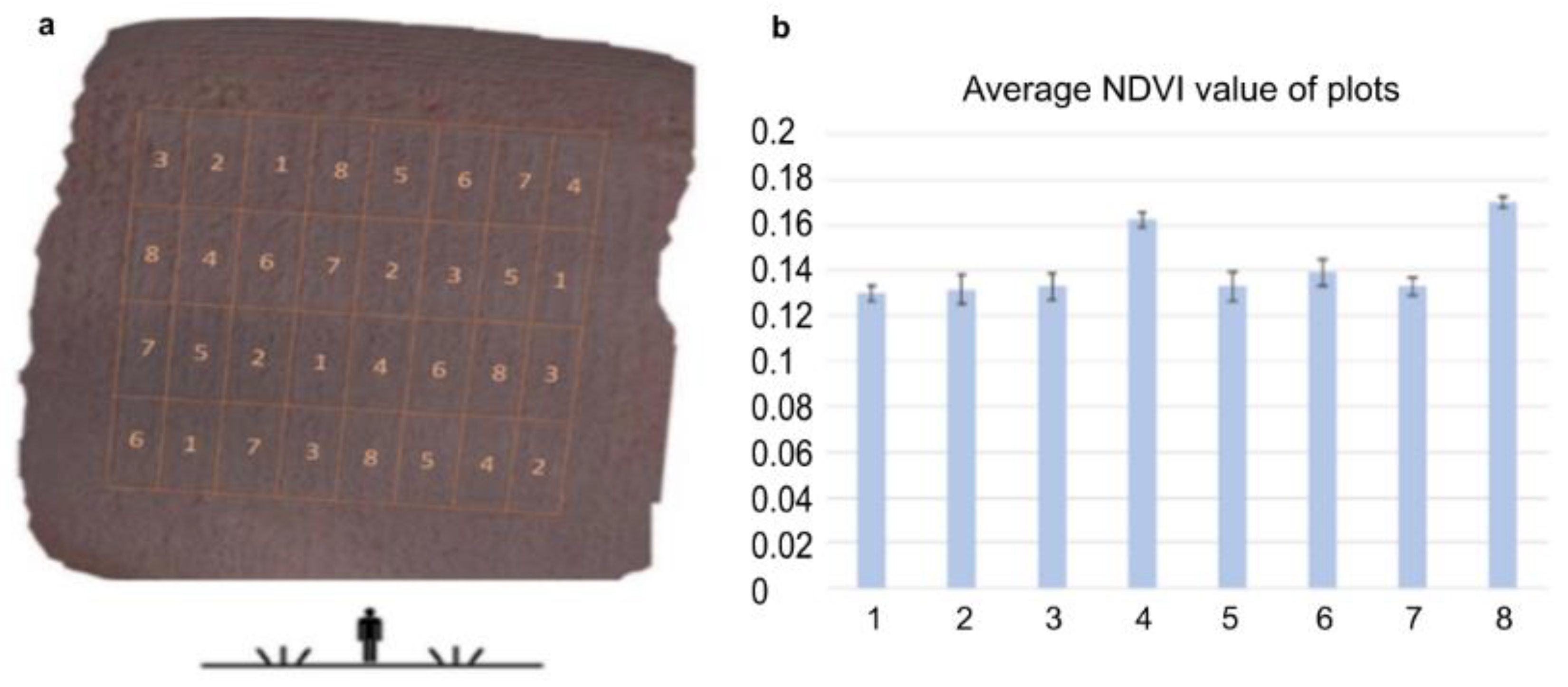



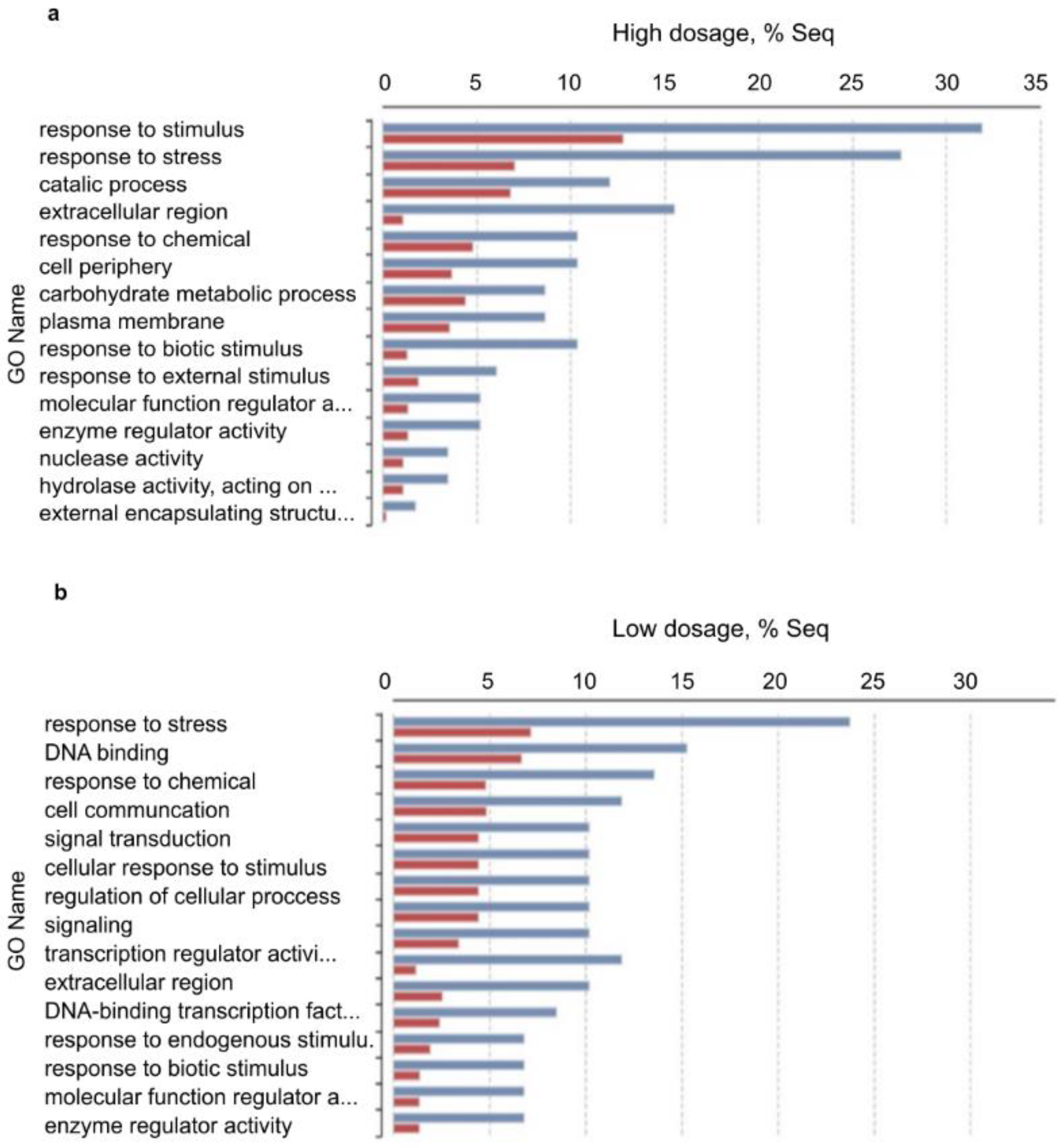
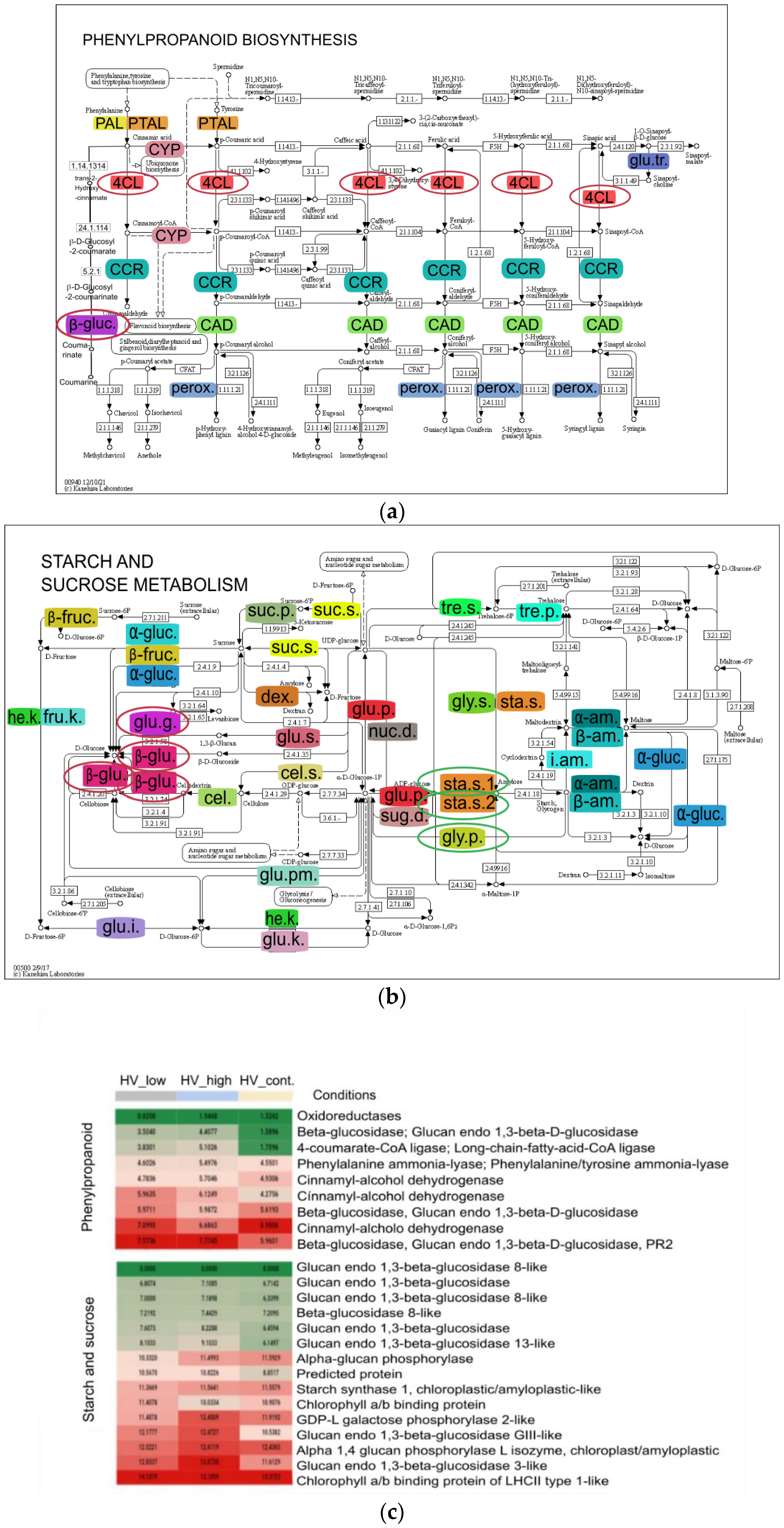
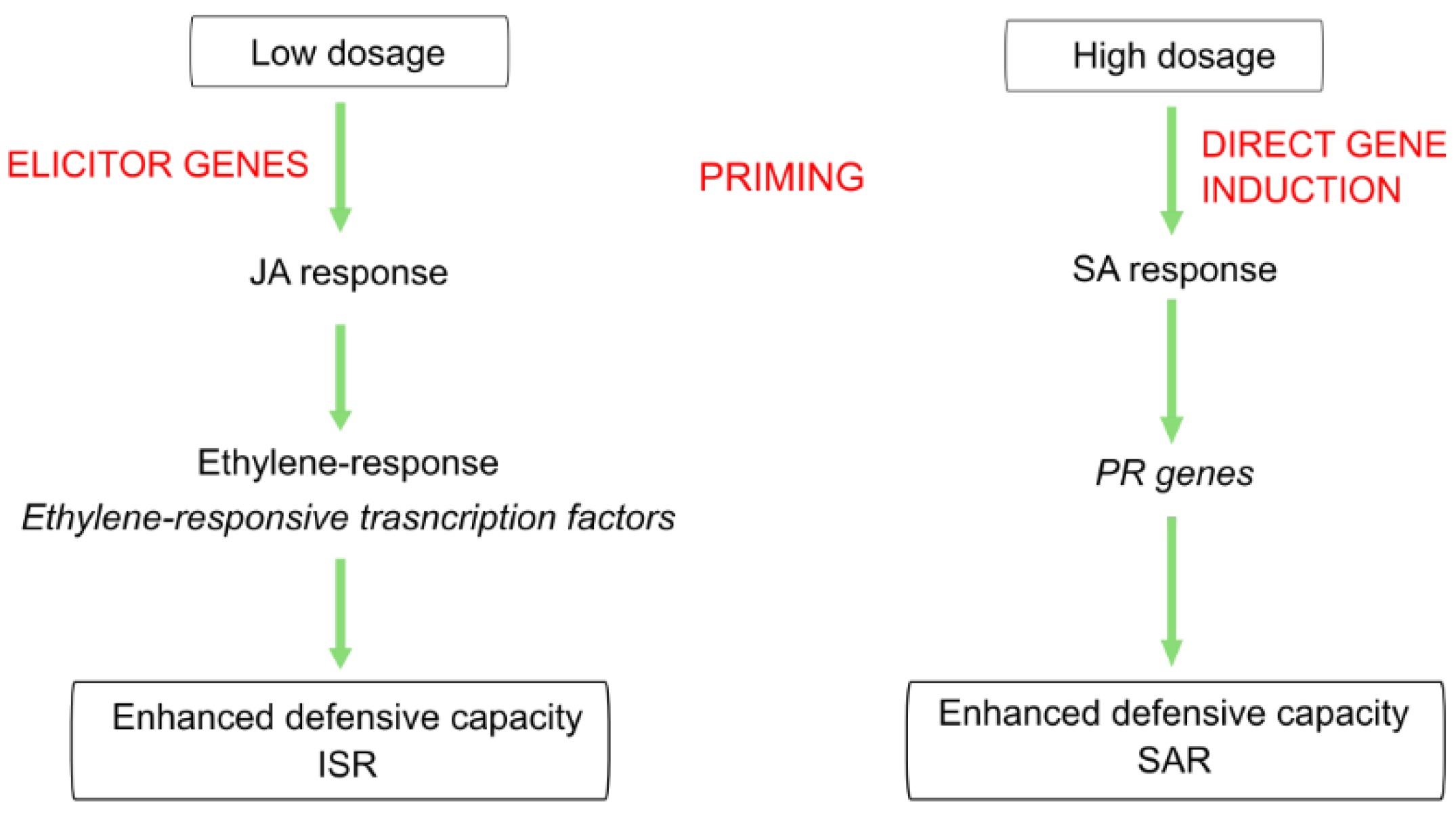
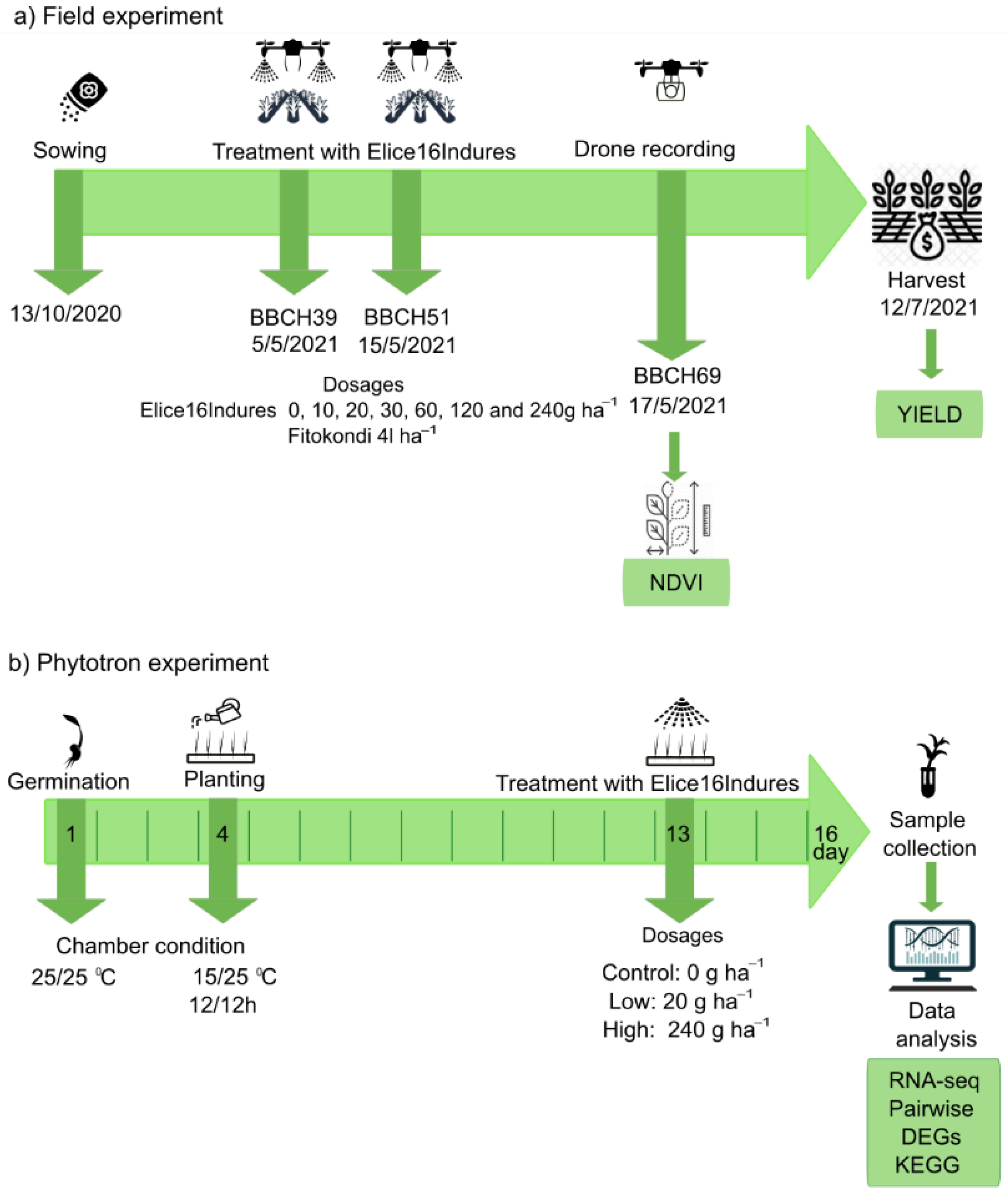
| Contig Length | Stats Based on All Transcripts | Stats Based on the Longest Isoform Per Gene |
|---|---|---|
| N10 | 3271 | 3204 |
| N20 | 2501 | 2466 |
| N30 | 2074 | 2054 |
| N40 | 1783 | 1765 |
| N50 | 1538 | 1524 |
| Median | 1023 | 997 |
| Average | 1232.5 | 1209.74 |
| Contig ID | Enzyme Description | GO Names |
|---|---|---|
| Shared | ||
| TRINITY_DN10333_c0_g1 TRINITY_DN370_c0_g1 | NDR1/HIN1-like protein 10 | P:response to stress; P:response to external stimulus; P:response to biotic stimulus; C:plasma membrane |
| TRINITY_DN1083_c0_g1 TRINITY_DN23_c1_g1 | peroxidase 1-like root peroxidase | P:response to stress; P:catabolic process; P:cellular process; P:response to chemical; F:catalytic activity; F:binding; C:extracellular region |
| TRINITY_DN10948_c0_g1 | putative protease inhibitor | P:response to stress; P:protein metabolic process; F:enzyme regulator activity |
| TRINITY_DN10986_c0_g1 | asparagine synthetase (glutamine-hydrolyzing) | P:response to stress; P:cell communication; P:biosynthetic process; P:response to external stimulus; P:response to chemical; F:nucleotide binding; F:catalytic activity |
| TRINITY_DN2054_c0_g1 | Subtilisin-chymotrypsin inhibitor-2B | P:response to stress; P:protein metabolic process; F:enzyme regulator activity |
| TRINITY_DN28_c0_g1 TRINITY_DN914_c0_g1 | glucan endo-1,3-beta-glucosidase GIII-like (PR2) | P:carbohydrate metabolic process; P:response to stress; F:hydrolase activity; C:plasma membrane |
| TRINITY_DN3218_c0_g1 | protein TIFY 11b-like (TF) | P:response to stress; P:signal transduction; P:response to endogenous stimulus; P:response to chemical; C:nucleus |
| TRINITY_DN326_c0_g1 TRINITY_DN5974_c0_g1 | WRKY transcription factor (TF) WRKY transcription factor WRKY24-like | P:response to stress; P:signal transduction; P:response to external stimulus; P:response to biotic stimulus; P:response to abiotic stimulus; P:response to endogenous stimulus; P:response to chemical; F:DNA binding; F:chromatin binding; F:DNA-binding transcription factor activity; C:nucleus |
| TRINITY_DN505_c0_g1 TRINITY_DN505_c0_g2 | pathogenesis-related protein 1 (PR1) | P:response to stress; P:response to biotic stimulus; C:extracellular region |
| TRINITY_DN505_c0_g3 | pathogenesis-related protein PRB1-2-like | P:response to stress; P:response to biotic stimulus; C:extracellular region |
| TRINITY_DN7081_c0_g1 TRINITY_DN7081_c0_g2 | nematode resistance protein-like HSPRO1 | P:response to stress; P:catabolic process; P:cellular process; F:binding |
| High dosage treatment of ELICE16INDURES | ||
| TRINITY_DN1035_c0_g1 TRINITY_DN623_c0_g1 TRINITY_DN1_c1_g1 TRINITY_DN2970_c0_g1 TRINITY_DN3188_c1_g1 | peroxidase 1-like peroxidase 2-like peroxidase 5-like peroxidase 50-like | P:response to stress; P:catabolic process; P:cellular process; P:response to chemical; F:catalytic activity; F:binding; C:extracellular region |
| TRINITY_DN11193_c0_g1 | auxin-responsive protein SAUR36-like | P:transport; P:signal transduction; P:response to endogenous stimulus; P:growth; P:response to chemical; C:cytoplasm |
| TRINITY_DN11681_c0_g1 | pathogenesis-related protein PR-4-like (PR4) Acting on ester bonds | P:response to stress; P:response to external stimulus; P:response to biotic stimulus; F:nuclease activity |
| TRINITY_DN12031_c0_g1 TRINITY_DN2721_c0_g1 | alpha-amylase/trypsin inhibitor-like | P:response to stress |
| TRINITY_DN12087_c0_g1 | putative lipid-transfer protein | P:response to stress; P:response to external stimulus; P:response to biotic stimulus; F:lipid binding |
| TRINITY_DN1303_c0_g1 | protein SRC2 homolog | P:response to stress; C:membrane |
| TRINITY_DN1308_c0_g5 | pathogenesis-related protein (PR5) | P:response to stress; P:response to biotic stimulus |
| TRINITY_DN1552_c0_g1 | subtilisin-chymotrypsin inhibitor-2A-like | P:response to stress; P:protein metabolic process; F:enzyme regulator activity |
| TRINITY_DN1626_c0_g2 | barwin-like (PR4) | P:response to stress; P:response to external stimulus; P:response to biotic stimulus |
| TRINITY_DN21_c0_g1 | putative wall-associated receptor kinase-like 16 Transferring phosphorus-containing groups | P:signal transduction; P:protein modification process; F:nucleotide binding; F:kinase activity; F:carbohydrate binding; C:membrane |
| TRINITY_DN4772_c0_g1 | MLO-like protein 1 | P:response to stress; P:response to biotic stimulus; F:protein binding; C:membrane |
| TRINITY_DN875_c0_g2 | predicted protein | P:response to stress; C:nucleus |
| TRINITY_DN9594_c0_g1 | pathogenesis-related protein 1-like (PR1) | P:response to stress; P:response to biotic stimulus; C:extracellular region |
| Low dosage treatment of ELICE16INDURES | ||
| TRINITY_DN7081_c0_g2 | nematode resistance protein-like HSPRO1 | P:response to stress; P:catabolic process; P:cellular process; F:binding |
| TRINITY_DN914_c0_g1 | glucan endo-1,3-beta-glucosidase GIII-like (PR2) | P:carbohydrate metabolic process; P:response to stress; F:hydrolase activity; C:plasma membrane |
| TRINITY_DN9142_c0_g3 | ethylene-responsive transcription factor 2-like | P:signal transduction; P:response to endogenous stimulus; P:response to chemical; F:DNA binding; F:DNA-binding transcription factor activity; C:nucleus |
| TRINITY_DN2054_c0_g1 | Subtilisin-chymotrypsin inhibitor-2B | P:response to stress; P:protein metabolic process; F:enzyme regulator activity |
| Pathways | Nr of KEGGs | Nr of Sequences | Nr of DEGs |
|---|---|---|---|
| High Dosage Treatment of ELICE16INDURES vs. Control | |||
| Amino sugar and nucleotide sugar metabolism | ko00520 | 85 | 1 |
| Alanine, aspartate and glutamate metabolism | ko00250 | 41 | 1 |
| Carbon fixation in photosynthetic organisms | ko00710 | 54 | 1 |
| Citrate cycle (TCA cycle) | ko00020 | 44 | 1 |
| Fatty acid biosynthesis | ko00061 | 26 | 1 |
| Fatty acid degradation | ko00071 | 30 | 1 |
| Glycolysis/Gluconeogenesis | ko00010 | 94 | 1 |
| Other glycan degradation | ko00511 | 33 | 2 |
| Purine metabolism | ko00230 | 450 | 1 |
| Pyruvate metabolism | ko00620 | 76 | 1 |
| Thiamine metabolism | ko00730 | 402 | 1 |
| Ubiquinone and other terpenoid-quinone biosynthesis | ko00130 | 59 | 1 |
| Low dosage treatment of ELICE16INDURES vs. control | |||
| Cutin, suberine and wax biosynthesis | ko00073 | 25 | 1 |
| Drug metabolism-cytochrome P450 | ko00982 | 53 | 1 |
| Drug metabolism-other enzymes | ko00983 | 105 | 1 |
| Glutathione metabolism | ko00480 | 58 | 1 |
| Metabolism of xenobiotics by cytochrome P450 | ko00980 | 48 | 1 |
| Other glycan degradation | ko00511 | 33 | 1 |
| Shared | |||
| Phenylpropanoid biosynthesis | ko00940 | 73 | 9 |
| Alanine, aspartate and glutamate metabolism | ko00250 | 41 | 1 |
| Cyanoamino acid metabolism | ko00460 | 35 | 3 |
| Fructose and mannose metabolism | ko00051 | 54 | 1 |
| Starch and sucrose metabolism | ko00500 | 142 | 5 |
Publisher’s Note: MDPI stays neutral with regard to jurisdictional claims in published maps and institutional affiliations. |
© 2022 by the authors. Licensee MDPI, Basel, Switzerland. This article is an open access article distributed under the terms and conditions of the Creative Commons Attribution (CC BY) license (https://creativecommons.org/licenses/by/4.0/).
Share and Cite
Hegedűs, G.; Kutasy, B.; Kiniczky, M.; Decsi, K.; Juhász, Á.; Nagy, Á.; Pallos, J.P.; Virág, E. Liposomal Formulation of Botanical Extracts may Enhance Yield Triggering PR Genes and Phenylpropanoid Pathway in Barley (Hordeum vulgare). Plants 2022, 11, 2969. https://doi.org/10.3390/plants11212969
Hegedűs G, Kutasy B, Kiniczky M, Decsi K, Juhász Á, Nagy Á, Pallos JP, Virág E. Liposomal Formulation of Botanical Extracts may Enhance Yield Triggering PR Genes and Phenylpropanoid Pathway in Barley (Hordeum vulgare). Plants. 2022; 11(21):2969. https://doi.org/10.3390/plants11212969
Chicago/Turabian StyleHegedűs, Géza, Barbara Kutasy, Márta Kiniczky, Kincső Decsi, Ákos Juhász, Ágnes Nagy, József Péter Pallos, and Eszter Virág. 2022. "Liposomal Formulation of Botanical Extracts may Enhance Yield Triggering PR Genes and Phenylpropanoid Pathway in Barley (Hordeum vulgare)" Plants 11, no. 21: 2969. https://doi.org/10.3390/plants11212969
APA StyleHegedűs, G., Kutasy, B., Kiniczky, M., Decsi, K., Juhász, Á., Nagy, Á., Pallos, J. P., & Virág, E. (2022). Liposomal Formulation of Botanical Extracts may Enhance Yield Triggering PR Genes and Phenylpropanoid Pathway in Barley (Hordeum vulgare). Plants, 11(21), 2969. https://doi.org/10.3390/plants11212969






